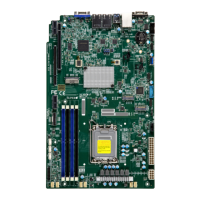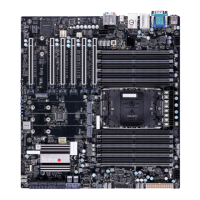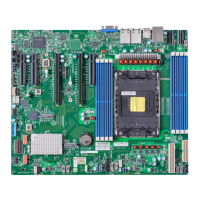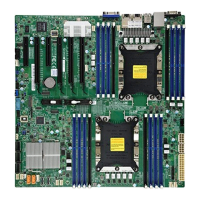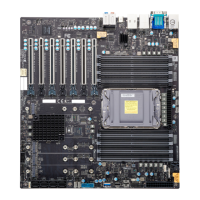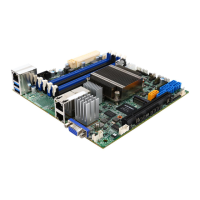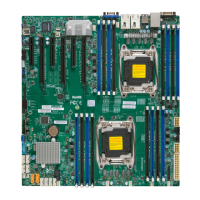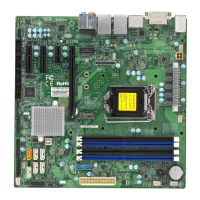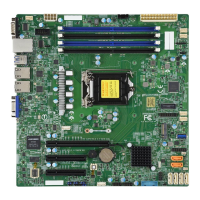Do you have a question about the Supermicro X13DEG-OA and is the answer not in the manual?
Provides an overview of the motherboard and links to essential resources like manuals, drivers, and support.
Details core motherboard features including CPU, memory, chipset, expansion slots, BMC, I/O, and BIOS.
Details supported processor features like UPI, accelerators, and I/O, plus PCH features like PCIe lanes and Ethernet.
Explains special features like AC power loss recovery and system health monitoring for voltage, fans, and temperature.
Details ACPI features, power supply requirements, system reboot behavior, and serial port specifications.
Provides critical precautions for handling static-sensitive devices and instructions for unpacking the motherboard.
Details the process of assembling the CPU and heatsink module, including processor type identification.
Details the components of the Processor Heatsink Module and provides an overview of its assembly process.
Covers motherboard installation, necessary tools, and guides on locating mounting holes.
Details motherboard memory support, including capacity, speeds, and specific DDR5 configurations.
Details the correct procedures for inserting and removing DIMMs into the memory slots.
Details rear I/O, USB, front panels, LEDs, power, fans, BMC, NC-SI, Chassis Intrusion, M.2, MCIO, and SATA connectors.
Explains how jumpers function and provides a step-by-step procedure for clearing CMOS settings.
Provides general procedures for troubleshooting system issues, including pre-power on checks and no power scenarios.
Addresses troubleshooting steps for common issues like no video output, system boot failures, and memory errors.
Guides users on identifying causes of system instability during or after OS installation.
Provides procedures for contacting technical support and information on downloading BIOS updates.
Answers common questions regarding motherboard memory support and the process for updating the system BIOS.
Details the correct procedures for removing, disposing of, and installing the onboard system battery.
Introduces the UEFI BIOS setup utility, its storage, upgrade methods, and how to access it.
Details the main BIOS setup screen, displaying system information and allowing configuration of date, time, and versions.
Configures boot behavior, including POST messages vs. logo display and Option ROM display modes.
Covers settings for NumLock state, error handling, boot retry, and power management functions like Watch Dog timer.
Displays CPU information and configures advanced power management settings for performance and energy efficiency.
Configures optimized power modes and CPU performance tuning features like SpeedStep and Turbo Mode.
Manages hardware power states, frequency prioritization, and CPU C-state configurations for power saving.
Configures advanced CPU features including prefetchers, virtualization, SMX, PPIN, AES-NI, and address limitations.
Manages memory encryption features like TME, TME-MT, and TDX for enhanced data security.
Configures Intel Software Guard Extensions (SGX) for application security and enclave management.
Allows configuration of North Bridge settings and displays uncore information like CPU count and UPI link speed.
Configures UPI link behavior, cache prefetching, IO directory cache, and Sub NUMA Clustering (SNC).
Configures memory refresh (ADR), mirroring for security, page policy, and RAS settings.
Configures PCIe port bifurcation settings and link speeds for various IIO ports.
Manages advanced PCIe features, CXL security, and Enhanced Downstream Port Containment (eDPC) settings.
Configures USB support, port emulation, PCIe clocking, and displays Server ME information.
Enables/disables SATA controllers, selects SATA mode (AHCI/RAID), and configures link power management and SGPIO.
Configures Serial Port 1 and Serial Port 2, including I/O addresses, IRQ assignments, and SOL support.
Configures network boot options like PXE/HTTP, media detection, and MAC address settings.
Configures SMBIOS event logging, including enabling/disabling, erasing settings, and behavior when the log is full.
Enables security device support and manages administrator and user passwords for system access.
Configures Secure Boot settings, modes (Standard/Custom), CSM support, and audit mode workflow.
Selects the system's boot mode (Legacy, UEFI, Dual) and prioritizes boot devices.
Provides options to save changes, discard changes, reset to defaults, and exit the BIOS setup utility.
Provides references to online documentation for AMI BIOS checkpoint codes and update information.
Guides through installing the Operating System (OS), configuring RAID, and installing drivers.
Provides industry standard warnings regarding battery handling, including risks of explosion and proper replacement/disposal.
| Socket | LGA 4189 |
|---|---|
| Storage Interface | SATA, NVMe |
| M.2 Slots | 2 |
| Networking | 2 x 10GBase-T (Intel X550-AT2) |
| SATA Ports | 8 x SATA 6Gb/s |
| Ethernet | 2 x 10GBase-T (Intel X550-AT2) |


